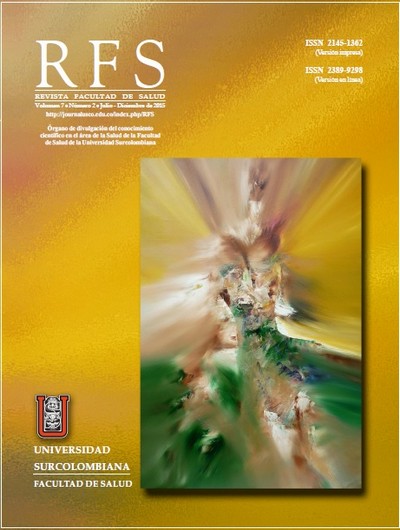Placenta accreta in late term abortion with subsequent hysterectomy
##plugins.themes.bootstrap3.article.main##
Placenta accreta in early pregnancy is not a common condition but one that should be considered as a severe complication of pregnancy, associated with massive antepartum or intrapartum haemorrhage which can be life-threatening. This study presents the case of a patient with a previous caesarean birth and a second semester scan showing placenta accreta, regarded as an inevitable cause for abortion at 20 weeks of pregnancy. Following cervical ripening and expulsion of the foetus with placental retention and massive bleeding, an emergency subtotal hysterectomy was required with recovery after surgery. The pathology study showed placenta accreta. Abnormal placentation in early pregnancy has seen a marked increase due to the increase in caesareans in recent decades. The main objective of studying this case is to emphasise the importance of early recognition of changes of placentation in the first and second trimesters of pregnancy. In patients with risk factors, a thorough assessment looking for placenta accreta is necessary in order to be able to anticipate complications associated with this pathology and thus have a positive impact on the associated maternal morbidity and mortality.
Downloads
##plugins.themes.bootstrap3.article.details##
Publications Committee, Society for Maternal-Fetal Medicine. Belfort MA. Placenta accreta. Am J Obstet Gynecol. 2010;203:430-439.
Wong HS, Cheung YK, Zuccollo J, et al. Evaluation of sonographic diagnostic criteria for placenta accrete. J Clin Ultrasound. 2008;36:551-9.
Garmi G, Salim R. Epidemiology, etiology, diagnosis, and management of placenta accreta. Obstet Gynecol Int. 2012;2012:87392-9.
Eshkoli T, Weintraub AY, Sergienko R, et al. Placenta accreta: risk factors, perinatal outcomes, and consequences for subsequent births. Am J Obstet Gynecol. 2013;208:219.e1-7.
Timor-Tritsch I, Monteagudo A. Unforeseen consequences of the increasing rate of cesarean deliveries: early placenta accrete and cesarean scar pregnancy. A review. Am J Obstet Gynecol. 2012; 14-29.
Esh-Broder E, Ariel I, Abas-Bashir N, et al. Placenta accreta is associated with IVF pregnancies: a retrospective chart review. BJOG. 2011;118:1084-9.
Jauniaux E, Jurcovik D. Placenta accreta: Pathogenesis of a 20th century of iatrogenic uterine disease. Placenta. 2012;33:244-251.
MacDorman MF, Menacker F, Declercq E. Cesarean birth in the United States: epidemiology, trends and outcomes. Clin Perinatol. 2008;35(2):293-307.
Hamilton BE, Martin JA, Ventura SJ. Births: preliminary data for 2010. Natl Vital Stat Rep. 2011;60(2):1-26.
Silver RM, Landon MB, Rouse DJ, et al. Maternal morbidity associated with multiple repeat cesarean deliveries. Obstet Gynecol. 2006;107(6):1226-32.
Wortman AC, Alexander JM. Placenta Accreta, Increta and Percreta. Obstet Gynecol Clin N Am. 2013(40):137-154.
Miller DA, Chollet JA, Goodwin TM. Clinical risk factors for placenta previa-placenta accrete. Am J Obtet Gynecol. 1997;177(1):210-4.
Rashbaum WK, Gates EJ, Jones J, et al. Placenta accreta encountered during dilation and evacuation in the second trimester. Obstetrics and Gynecology.1995;85:701-703.
Lone F, Sultan AH, Thakar R, et al. Risk factors and management patterns for emergency obstetric hysterectomy over 2 decades. International Journal of Gynecology and Obstetrics. 2010;109:12-15.
Bretelle F, Courbière B, Mazouni C, et al. Management of placenta accreta: morbidity and outcome. European Journal of Obstetrics and Gynecology and Reproductive Biology. 2007;133:34-39.
Mazouni C, Gorincour G, Juhan V, et al. Placenta accreta: a review of current advances in prenatal diagnosis. Placenta. 2007;28:599-603.
Shih JC, Palacios Jaraquemada JM, Su YN, et al. Role of three-dimensional power Doppler in the antenatal diagnosis of placenta accreta: comparison with grayscale and color Doppler techniques. Ultrasound in Obstetrics & Gynecology. 2009;33:193-203.
Warshak CR, Eskander R, Hull AD, et al. Accuracy of ultrasonography and magnetic resonance imaging in the diagnosis of placenta accrete. Obstetrics & Gynecology. 2006;108:573-81.










